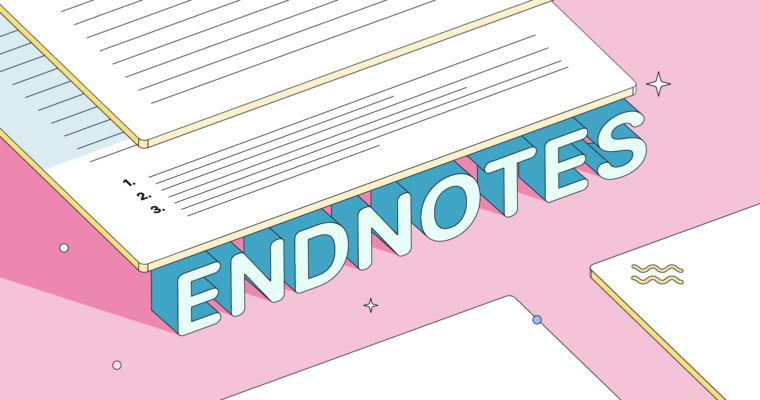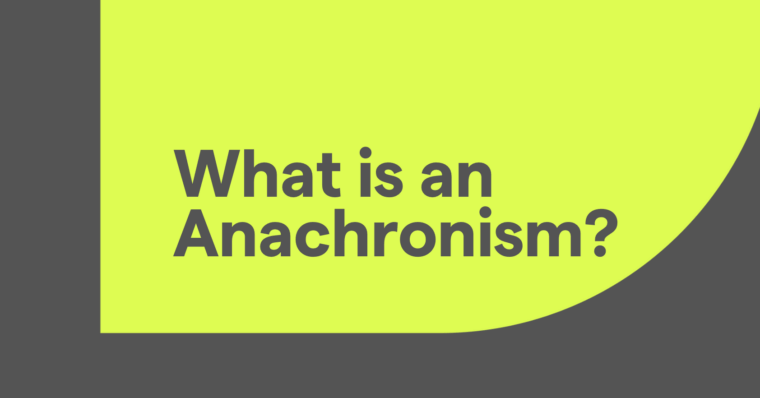
Endnotes are small notations at the end of a chapter, academic paper, article, or book that provide additional information or cite the source of a passage from a text. An endnote is typically marked by a superscript number (1) that corresponds to the matching endnote in the “Notes” section or page at the end of a piece of writing.
However, endnotes do more than just cite sources. They’re great for providing supplemental commentary that doesn’t fit with the text, especially longer passages that are too big for footnotes. Below, we explain how to use endnotes in Chicago style and MLA format, but first let’s answer the question “What is an endnote?”
What are endnotes?
Endnotes work like footnotes: A superscript number appears in the text and corresponds to a matching note elsewhere. In the case of endnotes, the actual notes appear on a separate page, usually titled “Notes,” at the end of a chapter, academic paper, article, or book. This “Notes” page does not replace the bibliography or works cited page but rather supports it.
The appeal of using endnotes (and footnotes) over in-text citations is that you can include more information. In-text citations tell only the bare minimum about the source, such as the author’s last name or year of publication. On the other hand, endnotes and footnotes can be longer, with more details, because they are situated outside of the main text.
When used for citing sources they’re a requirement, especially if your writing is having trouble passing a plagiarism checker. The major style guides all have their own rules for formatting such notes—with the exception of the APA format, which calls exclusively for footnotes.
How to create endnotes online
If you’re unfamiliar with how to use endnotes, sometimes it can be quicker to just use a citation generator rather than writing citations yourself.
Our citation generator lets you input all the details of a source and then creates your citation automatically, depending on which style guide you choose. All you have to do is click the copy button and paste the ready-made citation into your paper.
If your source is a website, you can also use our auto-citations feature. Using Grammarly for Windows or Mac, visit one of the thousands of compatible websites, such as Wikipedia, Frontiers, PLOS One, ScienceDirect, SAGE Journals, PubMed, Elsevier, DOAJ, arXiv, and Springer, and click the “Get citation” button in the bottom-left corner of the screen. You’ll receive both full and in-text citations of the page for whatever style guide you’re using.
Endnotes vs. footnotes: What’s the difference?
Endnotes and footnotes are often mixed up because they’re so closely related. Both use superscript numbers within the text that correspond to notes elsewhere. Both typically cover the same subject matter, like source citations or commentary. Generally, the main difference is where the notes are located:
- Endnotes are placed in a separate section or page after the work, typically at the end of a chapter, academic paper, article, or book.
- Footnotes are placed at the bottom of the page containing the passage they refer to.
In most cases, endnotes and footnotes are interchangeable, and they can occasionally be used together. If you have to choose between endnotes and footnotes, consider endnotes if you plan on writing lengthy notes. Endnotes accommodate longer notes well because they’re written on a separate page at the end of a work. Lengthy footnotes can be cumbersome because they take up too much room on a page.
Learn to use endnotes: Chicago style
The Chicago style is known for using both endnotes and footnotes. It offers two different options for citations: the notes-bibliography system, which uses either endnotes or footnotes, and the author-date system, which uses in-text citations.
If you’re using the notes-bibliography system, you can choose whether to use endnotes or footnotes. See the previous section if you’re having trouble deciding.
Endnotes are placed on their own page or section titled “Notes” after a piece of academic writing, whether a chapter, paper, or book. This “Notes” page comes after any appendixes but before the bibliography.
Endnote citations follow the same format as all Chicago citations. If the source is a book, the format should look like this:
#. Author’s first name and last name. Full Title of Work (City of publication: Publisher name, year of publication), page numbers.
The “#” refers to the number of the endnote. Keep in mind that, in endnotes, the number is written in normal type followed by a period. It is not in superscript like it is within the text.
Because endnotes are separated from the passage they relate to, it’s best to incorporate all the details so the readers don’t have to go back and forth. This means that, even if your notes are written as full sentences, you still need to include every detail in the endnote’s full citation.
On the “Notes” page, simply list each endnote in the order they appear. If your text is divided into chapters, then list the notes by chapter, using the chapter number, title, or both as a subheading.
In the text, it’s best to place the number marker at the end of a sentence, after the period. Otherwise, you can place them at the end of a statement or phrase within a sentence, but again it comes after punctuation like a comma or semicolon. The only exception is the dash: The endnote number should come before a dash.
Even with footnotes or endnotes, the Chicago style still requires a separate bibliography with full citations for all the sources used. The title “Bibliography” is preferred, but “Works Cited” or “Literature Cited” is still acceptable.
Chicago endnote examples
In text:
“Frankl recalls the physical trials of his imprisonment with the objective sterility of an academic.1 It was this torment that led him to his conclusion: ‘suffering ceases to be suffering at the moment it finds a meaning.’”2
On “Notes” page:
- Specifically, Frankl mentions having to work in torn shoes and not being adequately protected from the weather, even in extreme cold or storms.
- Viktor Frankl, Man’s Search for Meaning (Boston: Beacon Press, 2006), 73.
Learn to use endnotes: MLA style
The MLA format is a little more relaxed about the rules for endnotes compared to the Chicago style. Although the MLA prefers in-text citations for sources, endnotes can still be used for:
- multiple sources in the same passage, which would be too distracting in-text
- identifying which edition or translation is used if there are multiple versions of a work
- content notes for supplemental information that didn’t fit into the page text
Endnotes are given a separate section at the end of a chapter, paper, or book, titled either “Notes” or “Endnotes.” Unlike the Chicago style, MLA uses superscript numbers at the beginning of each endnote. If the endnote is written in sentence style, place any relevant page numbers in parentheses as you would for an in-text citation.
MLA endnote examples
In text:
“Free from desire, you realize the mystery.”1
“Caught in desire, you see only the manifestations.”2
On “Notes” page:
1 This passage is alternatively translated as “the secret waits for the insight of eyes unclouded by longing.”
2 Citations of Tao Te Ching use Stephen Mitchell’s translation unless otherwise noted.
Endnote FAQs
What are endnotes?
Endnotes are small notations at the end of a chapter, academic paper, article, or book that provide additional information or cite the source of a passage from a text. Endnotes are written on a separate page at the end of a work, unlike footnotes, which come at the bottom of a page.
What is included in endnotes?
Endnotes can serve a variety of purposes: citing sources, adding extra information, directing readers to other areas, etc. Each style guide has its own formatting requirements, but typically they follow the regular citation guidelines of the style guide.
What’s the difference between endnotes and footnotes?
Endnotes and footnotes are very similar in that they both provide supplemental information, including citations, outside of the main text. The difference is where they appear: Endnotes are placed at the end of a work on a separate page, while footnotes are placed at the bottom of the page containing the passage they refer to.





